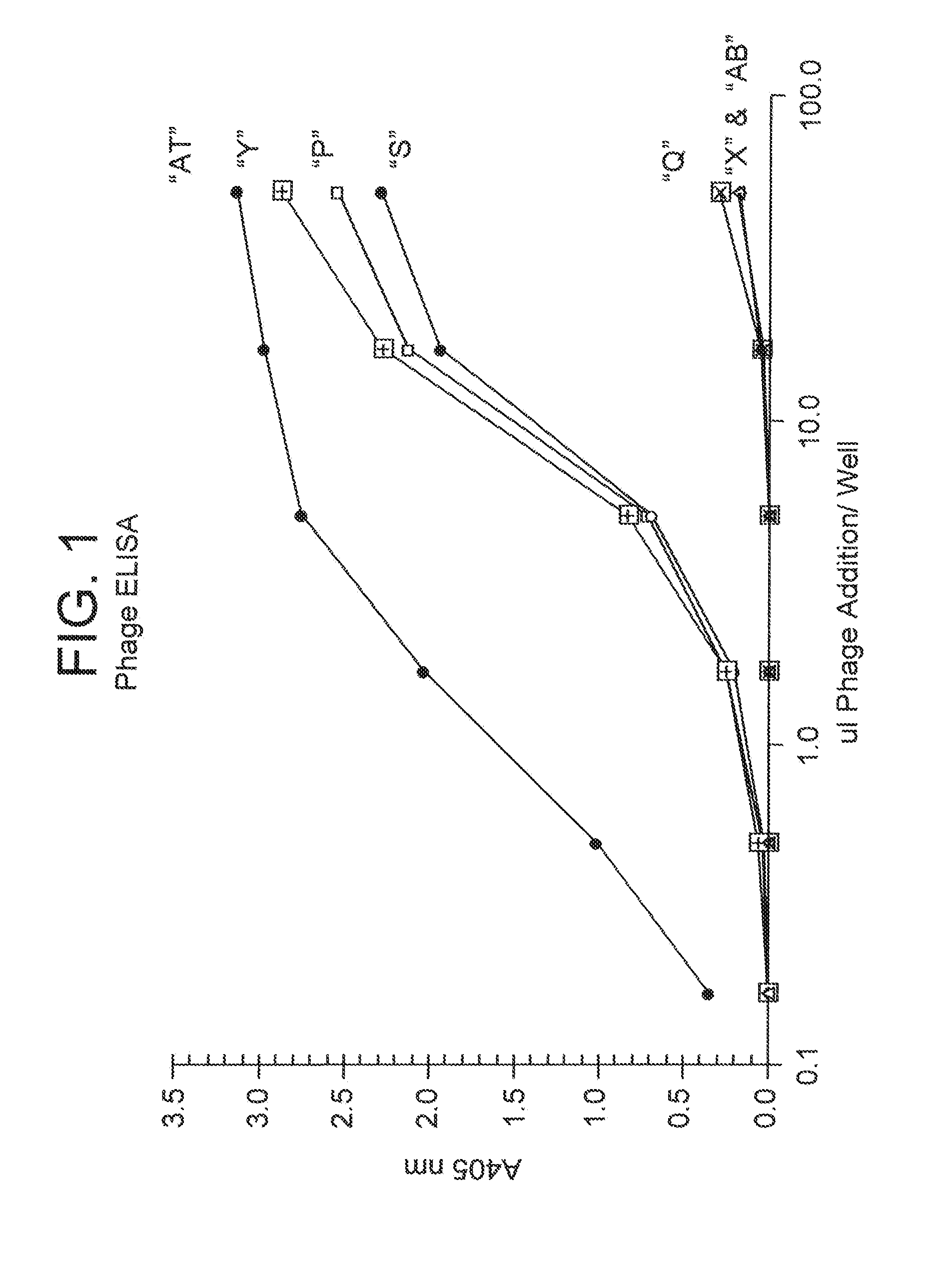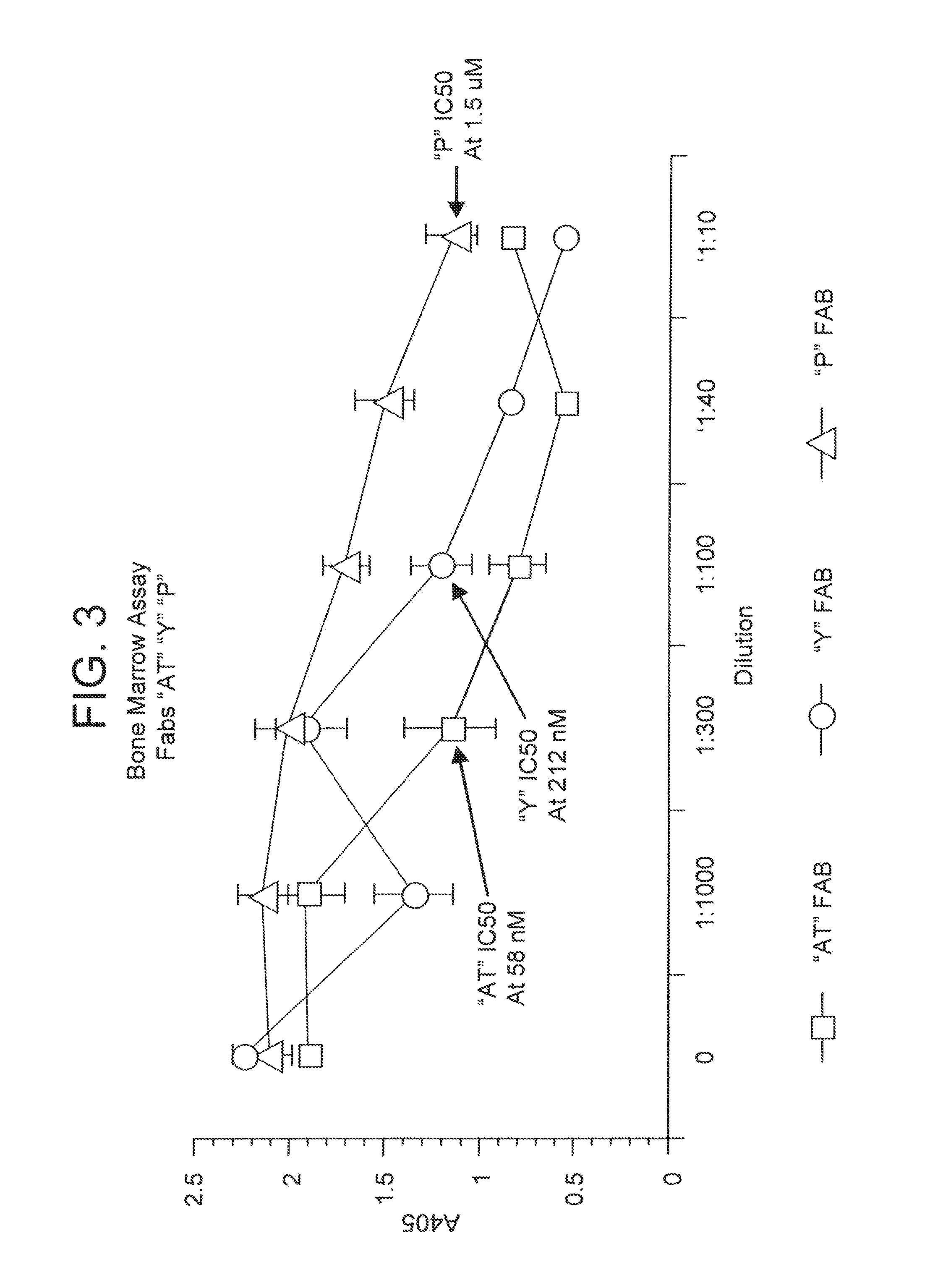Selective binding agents of osteoprotegerin binding protein
a technology of osteoprotegerin and binding protein, which is applied in the direction of peptides, drug compositions, metabolic disorders, etc., can solve the problems of reduced bone mass and strength, slow or incomplete repair of broken bones, and increased risk of fractures, so as to prevent and/or treat bone diseases, and prevent and/or treat bone loss.
- Summary
- Abstract
- Description
- Claims
- Application Information
AI Technical Summary
Benefits of technology
Problems solved by technology
Method used
Image
Examples
example 1
Reagents and Assays
[0253]The screening target used in these studies was prepared from expression of a cDNA encoding human OPGbp of amino acids 140 through 317 inclusive as shown in FIG. 4 of PCT WO98 / 46751 in a CHO host cell and purified as follows. A Q Sepharose column (Pharmacia) was equilibrated with 20 mM tris pH 8.5. Conditioned media which had also been titrated to pH 8.5 was applied, the column washed with the Tris buffer, and proteins were eluted with a 100-600 mM NaCl gradient over 20 column volumes. Fractions containing OPGL were identified through SDS-PAGE and Western blot analysis. OPGbp containing fractions were then titrated to pH 4.8 and applied to a Sp column (Pharmacia) which had been equilibrated with 20 mM sodium acetate pH 4.8. After washing, proteins were eluted with a 0-0.3M NaCl gradient followed by 0.5M and 1M NaCl steps. OPGbp eluted with all buffers however only the 0-0.3M NaCl gradient fractions were found to be active in vitro osteoclast stimulating bioas...
example 2
Screening of a Human Fab library
[0263]A library of about 4×1010 unique human Fab fragments prepared in bacteriophage M13 was obtained from Target Quest, NV (Amsterdam, Netherlands). General procedures for construction and screening human Fab libraries were described in de Haard et al. (Advanced Drug Delivery Reviews 31, 5-31 (1998); J. Biol. Chem. 274, 18218-18230 (1999)). The library was screened for Fab fragments which bind to OPGbp [143-317] by the following procedures.
Solid Phase Direct Plating
[0264]OPGbp [143-317] prepared as described above was immobilized on a solid phase using Nunc Maxisorb immunotubes (12× 75 mm, 5 ml capacity) by directly plating on the solid phase at a protein concentration of 1.5 μg / ml in TBS, pH 8.0 (TBS was Tris buffered saline: 10 mM Tris (pH 7.5), 150 mM NaCl) at room temperature for 2 hours. These conditions permitted 80% of maximum plating of the solid phase at 2 hours (maximum at 2 hours was still nonsaturating) while retaining binding capabilitie...
example 3
Identification of Fab Clones which Bind OPGbp
[0271]E. coli TG1 cells were infected with the phage pool from an ELISA responsive round and individual colonies were picked for PCR analysis. Typically one to four plates of 96 colonies were picked for each selection. Fab cDNAs were amplified by PCR by a specific set of primers and analyzed on an agarose gel for Fab insert length. Fab insert lengths >1.6 kb were full length. cDNAs were also digested with BstNI restriction enzyme and the banding pattern analyzed by electorphoresis on agarose gels. Clones which exhibited identical size PCR full-length inserts and identical BstNI banding patterns in two or more isolates were candidates for further analysis. Using the above criteria, the following Fabs were identified.
[0272]Fab pattern “P” was identified after solution phase screening using three rounds of elution with triethylamine, pH 12, followed by solid phase screening as described above using one round of elution with 1 uM OPGbp [143-3...
PUM
| Property | Measurement | Unit |
|---|---|---|
| dissociation constant | aaaaa | aaaaa |
| concentration | aaaaa | aaaaa |
| concentration | aaaaa | aaaaa |
Abstract
Description
Claims
Application Information
 Login to View More
Login to View More - R&D
- Intellectual Property
- Life Sciences
- Materials
- Tech Scout
- Unparalleled Data Quality
- Higher Quality Content
- 60% Fewer Hallucinations
Browse by: Latest US Patents, China's latest patents, Technical Efficacy Thesaurus, Application Domain, Technology Topic, Popular Technical Reports.
© 2025 PatSnap. All rights reserved.Legal|Privacy policy|Modern Slavery Act Transparency Statement|Sitemap|About US| Contact US: help@patsnap.com



